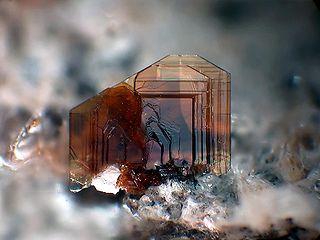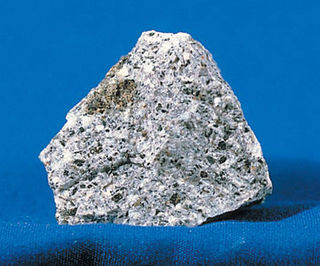Related Research Articles

Biotite is a common group of phyllosilicate minerals within the mica group, with the approximate chemical formula K(Mg,Fe)
3AlSi
3O
10(F,OH)
2. It is primarily a solid-solution series between the iron-endmember annite, and the magnesium-endmember phlogopite; more aluminous end-members include siderophyllite and eastonite. Biotite was regarded as a mineral species by the International Mineralogical Association until 1998, when its status was changed to a mineral group. The term biotite is still used to describe unanalysed dark micas in the field. Biotite was named by J.F.L. Hausmann in 1847 in honor of the French physicist Jean-Baptiste Biot, who performed early research into the many optical properties of mica.

Syenite is a coarse-grained intrusive igneous rock with a general composition similar to that of granite, but deficient in quartz, which, if present at all, occurs in relatively small concentrations. Some syenites contain larger proportions of mafic components and smaller amounts of felsic material than most granites; those are classed as being of intermediate composition. The volcanic equivalent of syenite is trachyte.

Phonolite is an uncommon extrusive rock, of intermediate chemical composition between felsic and mafic, with texture ranging from aphanitic (fine-grain) to porphyritic. Its intrusive equivalent is nepheline syenite.

Volcanic rock is a rock formed from lava erupted from a volcano. In other words, it differs from other igneous rock by being of volcanic origin. Like all rock types, the concept of volcanic rock is artificial, and in nature volcanic rocks grade into hypabyssal and metamorphic rocks and constitute an important element of some sediments and sedimentary rocks. For these reasons, in geology, volcanics and shallow hypabyssal rocks are not always treated as distinct. In the context of Precambrian shield geology, the term "volcanic" is often applied to what are strictly metavolcanic rocks. Volcanic rocks and sediment that form from magma erupted into the air are called "volcaniclastics," and these are technically sedimentary rocks.

The Richat Structure, also called Guelb er Richât, the Eye of Africa, or Eye of the Sahara is a prominent circular feature in the Sahara's Adrar Plateau, near Ouadane, west–central Mauritania, Northwest Africa. It is an eroded dome, 40 kilometres (25 mi) in diameter, exposing sedimentary rock in layers which appear as concentric rings. Igneous rock is exposed inside and there are spectacular rhyolites and gabbros which have undergone hydrothermal alteration, and a central megabreccia. The structure is also the location of exceptional accumulations of Acheulean archaeological artifacts.

Nepheline syenite is a holocrystalline plutonic rock that consists largely of nepheline and alkali feldspar. The rocks are mostly pale colored, grey or pink, and in general appearance they are not unlike granites, but dark green varieties are also known. Phonolite is the fine-grained extrusive equivalent.

Phlogopite is a yellow, greenish, or reddish-brown member of the mica family of phyllosilicates. It is also known as magnesium mica.

Ultramafic rocks are igneous and meta-igneous rocks with a very low silica content, generally >18% MgO, high FeO, low potassium, and are composed of usually greater than 90% mafic minerals. The Earth's mantle is composed of ultramafic rocks. Ultrabasic is a more inclusive term that includes igneous rocks with low silica content that may not be extremely enriched in Fe and Mg, such as carbonatites and ultrapotassic igneous rocks.

Carbonatite is a type of intrusive or extrusive igneous rock defined by mineralogic composition consisting of greater than 50% carbonate minerals. Carbonatites may be confused with marble and may require geochemical verification.
The tholeiitic magma series is one of two main magma series in subalkaline igneous rocks, the other being the calc-alkaline series. A magma series is a chemically distinct range of magma compositions that describes the evolution of a mafic magma into a more evolved, silica rich end member. Rock types of the tholeiitic magma series include tholeiitic basalt, ferro-basalt, tholeiitic basaltic andesite, tholeiitic andesite, dacite and rhyolite. The variety of basalt in the series was originally called tholeiite but the International Union of Geological Sciences recommends that tholeiitic basalt be used in preference to that term.

Larvikite is an igneous rock, specifically a variety of monzonite, notable for the presence of thumbnail-sized crystals of feldspar. These feldspars are known as ternary because they contain significant components of all three endmember feldspars. The feldspar has partly unmixed on the micro-scale to form a perthite, and the presence of the alternating alkali feldspar and plagioclase layers give its characteristic silver blue sheen on polished surfaces. Olivine can be present along with apatite, and locally quartz. Larvikite is usually rich in titanium, with titanaugite and/or titanomagnetite present.

The Magnet Cove igneous complex is a small alkalic ring complex lying to the west of the town of Magnet Cove in Hot Spring County, Arkansas. It and the adjacent town are so named due to the existence of magnetite and the terrain being a cove, a basin-shaped valley.

Igneous rock, or magmatic rock, is one of the three main rock types, the others being sedimentary and metamorphic. Igneous rock is formed through the cooling and solidification of magma or lava.
Banalsite is a rare barium, sodium aluminium silicate mineral with formula: BaNa2Al4Si4O16. Banalsite is a tectosilicate of the feldspar group.
Monte Muambe is volcanic caldera located south-east of Moatize in Tete Province of Mozambique

Rutan Hill is the local name for a hill on the United States Geological Survey Branchville 7.5-minute map. It is located about 2.46 miles (3.96 km) south-southwest of Colesville, New Jersey in the Wantage Township, of Sussex County, New Jersey in the United States. Rutan Hill rises about 270 feet (82 m) above the adjacent creek valley to an elevation of just over 1,020 feet (310 m). This hill lies entirely within private, posted property. This nondescript hill is the surface expression of a diatreme that is the northern part of the Late Ordovician Beemerville Alkaline Complex.

Fenite is a metasomatic alteration associated particularly with carbonatite intrusions and created, very rarely, by advanced carbon dioxide alteration (carbonation) of felsic and mafic rocks. Fenite alteration is known, but restricted in distribution, around high-temperature metamorphic talc carbonates, generally in the form of an aureole around ultramafic rocks. Such examples include biotite-rich zones, amphibolite-calcite-scapolite alteration and other unusual skarn assemblages. The process is called fenitization.

The geology of Finland is made up of a mix of geologically very young and very old materials. Common rock types are orthogneiss, granite, metavolcanics and metasedimentary rocks. On top of these lies is a widespread thin layer of unconsolidated deposits formed in connection to the Quaternary ice ages, for example eskers, till and marine clay. The topographic relief is rather subdued because mountain massifs were worn down to a peneplain long ago.
The Alnö Complex or Alnö Alkaline Complex is a group of carbonatite and alkaline igneous rocks in Alnö in the eastern coast of central Sweden that intruded the basement in Late Ediacaran times. The Alnö Complex is made up by a series of concentric dykes within a radius of 25 km of a main "central complex" of intrusions. In addition the Alnö Complex proper is surrounded by a 500 to 600 m broad zone of metasomatic rock that was formed by metasomatic alteration of the existing Precambrian migmatite gneiss basement. The specific type of metasomatic rock is referred by some authors as "fenite". The dykes of the complex consist of carbonatite and alkaline rocks such melilite and sövite.

The Kola Alkaline Province or Kola Alkaline Carbonatite Province is a discontiguous group of unusual igneous rocks centered in the Kola Peninsula of Russia and with ouliers in nearby areas of Finland and in Arkhangelsk Oblast across the White Sea. The province is made up of alkaline-ultramafic rock complexes often associated to carbonatites and stand-alone dykes and pipes made up of carbonatites, kimberlites and similar rocks. To this it adds the large nepheline syenite bodies of the Lovozero Massif and the Khibiny Mountains. An estimate puts the total volume of the rocks of the Kola Alkaline Province at 15,000 ±2,700 km3.
References
- 1 2 http://www.mindat.org/loc-14357.html Mindat location description
- ↑ Faure, Gunter (2000) Origin of Igneous Rocks, Springer, pp. 319-321 ISBN 3-540-67772-0
Coordinates: 59°16′04″N9°16′40″E / 59.2677°N 9.2779°E
| This article about a regional geological feature is a stub. You can help Wikipedia by expanding it. |
| This Vestfold og Telemark location article is a stub. You can help Wikipedia by expanding it. |